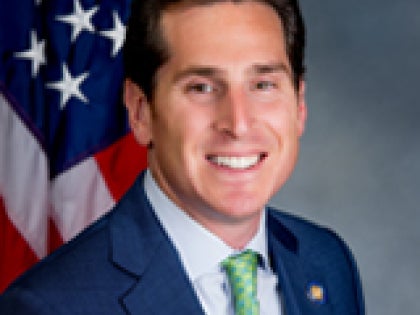
Cost of PSEG restoration/repairs more than $350 million, LIPA chief exec says
The tab for restoring power in the aftermath of Tropical Storm Isaias will top $350 million, a top LIPA official disclosed at a legislative hearing Thursday — potentially leaving ratepayers on the hook for as much as $90 million depending on federal government reimbursement.
LIPA chief executive Tom Falcone said the utility "may be eligible" for up to $260 million in reimbursements from the Federal Emergency Management Agency, which also covered more than $1.5 billion in storm and hardening costs for superstorm Sandy.
Some lawmakers at the online state hearing on PSEG's failures to restore power and communication after the storm, questioned the structure under which the utility operates.
Public Service Commission chairman John Rhodes also was on the hot seat at the hearing after more than 420,000 customers on Long Island lost power Aug. 4 and couldn’t communicate with PSEG to report outages and get accurate restoration times.
And, in a first, an Altice-Optimum official put a figure on the number of New Yorkers in its service areas that lost service: around 400,000 of the nearly 2 million downstate and Westchester customers at the height of the storm, according to written testimony by Altice chief operating officer Hakim Boubazine.
Falcone also took aim at PSEG’s outage management computer system, which the company recommended to be installed at a cost of $30.6 million in 2014, the year PSEG took over management of the system. PSEG in 2014, advocated for the system, which it owns, over a separate one that LIPA would have owned and been eligible for a $50 million state grant.
The system, Falcone said in written testimony, “failed to perform as designed.” He said the system undergoes twice-annual stress tests.
“The failure of these key systems is indefensible,” Falcone said in written testimony, “regardless of the challenges of the storm or with third-party vendors.”
LIPA, he said, formed an Isaias task force on Aug. 5, led by LIPA and the Department of Public Service with an outside consultant, and launched an independent review to review causes of the communication and restoration “lapses” during the Aug. 4 storm.
Falcone said PSEG’s failures in the storm’s aftermath “undermined” accomplishments it has made since 2014, including Wall Street ratings upgrades and customer satisfaction scores.
“PSEG Long Island’s failures during Isaias are inconsistent with these accomplishments and are simply unacceptable,” Falcone said in his written statement. “Long Islanders deserve better and they will get better.”
Rhodes noted the Department of Public Service, which he also oversees, already has sent notices of apparent violation to PSEG and Altice-Optimum, and that PSEG has agreed to forfeit upward of $10 million in incentive bonus money to pay for a reimbursement fund for ratepayers. Rhodes said the state would make sure utilities secure more staff in advance of big storms and clear up communication and communications systems.
But Sen. Todd Kaminsky (D-Long Beach) called it “disturbing” that the money PSEG planned to spend to reimburse customers for spoiled food was coming from the same ratepayer-funded incentive bonus pool that PSEG agreed to forfeit, rather than a check from PSEG’s parent shareholder funds.
Rhodes said the state “pressed PSEG for reimbursement to come out of shareholder money. Forfeiting the incentive is the immediately available way to do that. We will continue the investigation,” and could to impose further sanctions, he said.
Assemb. Fred Thiele (I-Sag Harbor) said his concern was that while the names of storms and the names of Long Island utilities that attempt to respond to them had changed over the years, the poor response remained the same.
“This has been déjà vu all over again,” he said. “I wonder if the problem is the organization of how this is set up … The public often doesn’t know who is responsible for what.”
Rhodes acknowledged that while PSEG and LIPA operate under “review and recommend” authority of the DPS, he maintained that the state regulator had the ability to hold the utilities on Long Island accountable.
“At this point, the issue is whether we have the authority and the teeth to hold them accountable, and with this structure we do,” he said. “With this structure, we have very clear lines of responsibility and accountability,” including performance metrics. “I believe the structure lines up pretty well for what we need.”
“But it just doesn’t seem to work, time and again,” Thiele pressed. “There’s clear responsibility, but the result is bad time and again.”
Thiele noted that the worst of the storm season remained ahead, and asked, “After such a complete failure on so many levels, how can you assure the public that by snapping your fingers overnight that we can fix it that fast?”
Rhodes said staffing increases and demanding communications and outage-work management computer systems that “do not crash” would help get through the short-term challenges.
Assemb. Steve Englebright (D-Setauket), pointed to a mailer a constituent received from PSEG the day of the storm boasting of recently finished storm hardening work that promised customers reliable service for “years to come,” in asking if the DPS was “monitoring this propaganda” in light of the recent restoration failures. He also questioned DPS’s overall oversight of the utility.
“The oversight you are supposed to be providing has apparently also failed,” Englebright told Rhodes. “Meanwhile the ratepayers have been giving them bonuses for their [PSEG’s] supposed preparation. So I’m skeptical. But that [oversight] certainly hasn’t been the track record.”
Rhodes said “obviously we don’t agree with the mailer,” but pushed back on a report that questioned the department’s monitoring function. “We are absolutely focused that in cases of the failures here that we get it we right,” Rhodes said, “that we pursue the investigation, and we are going faster than in the past, more rigorous than in the past, and no tool is off the table … No outcome is off the table, including termination for PSEG.”
During questioning at the legislative hearing, Tom Congdon, executive deputy and deputy chair of the Department of Public Service said an early estimate of the cost to restore power on Long Island after Tropical Storm Isaias was around $300 million. Superstorm Sandy restoration costs exceeded $700 million on Long Island.
Altice has already received a notice of apparent violation by the Department of Public Service for its performance in the storm’s aftermath, charging that Altice’s response was “wholly inadequate.” The state charged Altice “apparently failed” to follow its PSC-ordered resiliency plan relating to network planning, customer service and communications and government coordination.
The state said it understood that “many thousands” of customers remained without Optimum service as late as Aug. 16.
“At this point it the investigation, the Department has determined that Altice was ill-prepared for the storm and failed to comply with many aspects” of its severe weather and resiliency plans.
Boubazine cited power loss as a major cause of the service outage.
“In this recent storm, as is usual, the vast majority of our customers lost our services due to the loss of commercial power,” he said. “As commercial power was restored, the majority of our customers came back online.” He said Altice had nearly 1,000 field repair workers on the ground restoring service, compared with more than 6,500 for PSEG personnel in New York State who worked around the clock to repair damage and restore Optimum
Boubazine said Altice experienced “issues” with two computer systems “mainly due to the surge of usage that created challenges for our customers to reach us via phone,” and get information on outage status, even by logging into their Optimum account.
“We addressed those issues as quickly as possible, but understand the frustration felt by our customers,” he said, offering an apology for the “inconvenience.” Some customers as recently as this week have said they continued to be without Optimum service.
Altice will provide credits for the outages that Boubazine said “will exceed our regulatory obligations,” for internet and phone, not just video service.
DPS has ordered Altice to make plans to secure additional crews and equipment before and during storms, better work with local governments emergency response teams, develop plans to deploy and monitor power supplies, generators and back up generators for use during storms and restoration.
“Altice's apparent failure to follow the Commission's merger order directives is a serious matter and provides grounds for several possible additional actions by the Commission against the company,” including the ability to revoke Altice’s operating certificates in the state.
PSC chairman Rhodes, in testimony, said the agency was “deadly serious” about fixing problems at utilities.
“It’s very clear at this time that New York State is willing to use the stick,” not just carrots, to fix the problems, Rhodes said.
